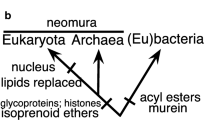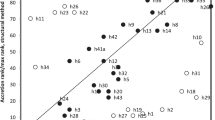Abstract
The substitution rate of the individual positions in an alignment of 750 eukaryotic small ribosomal subunit RNA sequences was estimated. From the resulting rate distribution, an equation was derived that gives a more precise relationship between sequence dissimilarity and evolutionary distance than hitherto available. Trees constructed on the basis of evolutionary distances computed by this new equation for small ribosomal subunit RNA sequences from ciliates, apicomplexans, dinoflagellates, oomycetes, hyphochytriomycetes, bicosoecids, labyrinthuloids, and heterokont algae show a more consistent tree topology than trees constructed in the absence of “substitution rate calibration.” In particular, they do not suffer from anomalies caused by the presence of extremely long branches.
Similar content being viewed by others
References
De Rijk P, De Wachter R (1993) DCSE, an interactive tool for sequence alignment and secondary structure research. Comput Appl Biosci 9:735–740
De Rijk P, Van de Peer Y, Van den Broeck I, De Wachter R (1995) Evolution according to large ribosomal subunit RNA. J Mol Evol 41:366–375
Felsenstein J (1985) Confidence limits on phylogenies: an approach using the bootstrap. Evolution 39:783–791
Gajadhar AA, Marquardt WC, Hall R, Gunderson J, Ariztia-Carmona EV, Sogin ML (1991) Ribosomal RNA sequences ofSarcocystis muris, Theileria annulata, andCrypthecodinium cohnii reveal evolutionary relationships among apicomplexans, dinoflagellates, and ciliates. Mol Biochem Parasitol 45:147–154
Goggin CL, Barker SC (1993) Phylogenetic position of the genusPerkinsus (Protista, Apicomplexa) based on small subunit ribosomal RNA. Mol Biochem Parasitol 60:65–70
Jin L, Nei M (1990) Limitations of the evolutionary parsimony method of phylogenetic analysis. Mol Biol Evol 7:82–102
Jukes TH, Cantor CR (1969) Evolution of protein molecules. In: Munro HH (ed) Mammalian protein metabolism. New York: Academic Press, pp 21–132
Kimura M (1980) A simple method for estimating evolutionary rates of base substitutions through comparative studies of nucleotide sequences. J Mol Evol 16:111–120
Knoll AH (1992) The early evolution of eukaryotes: a geological perspective. Science 256:622–627
Leipe DD, Wainright PO, Gunderson JH, Porter D, Patterson DJ, Valois F, Himmerich S, Sogin ML (1994) The stramenopiles from a molecular perspective: 16S-like rRNA sequences fromLabyrinthuloides minuta andCafeteria roenbergensis. Phycologia 33:369–377
Olsen GJ (1987) Earliest phylogenetic branchings: comparing rRNA-based evolutionary trees inferred with various techniques. Cold Spring Harbor Symp Quant Biol LII:825–837
Patterson DJ (1989) Stramenopiles: chromophytes from a protistan perspective. In: Green JC, Leadbeater BSC, Diver WL (eds) The chromophyte algae: problems and perspectives. Oxford: Clarendon, pp 357–379
Patterson DJ, Sogin ML (1992) Eukaryote origins and protistan diversity. In: Hartman H, Matsuno K (eds) The origin and evolution of prokaryotic and eukaryotic cells. New Jersey: World Scientific, pp 13–46
Pawlowski J, Bolivar I, Guiard-Maffia J, Gouy M (1994) Phylogenetic position of Foraminifera inferred from LSU rRNA gene sequences. Mol Biol Evol 11:929–938
Preisig HR, Anderson OR, Corliss JO, Moestrup O, Powell MJ, Roberson RW, Wetherbee R (1994) Terminology and nomenclature of protist cell surface structures. Protoplasma 181:1–28
Saitou N, Nei M (1987) The neighbor-joining method: a new method for reconstructing phylogenetic trees. Mol Biol Evol 4:406–425
Saitou N, Imanishi T (1989) Relative efficiencies of the Fitch-Margoliash, maximum-parsimony, maximum-likelihood, minimum-evolution, and neighbor-joining methods of phylogenetic tree construction in obtaining the correct tree. Mol Biol Evol 6:514–525
Saunders GW, Potter D, Paskind MP, Andersen RA (1995) Cladistic analyses of combined traditional and molecular data sets reveal an algal lineage. Proc Natl Acad Sci USA 92:244–248
Sourdis J, Nei M (1988) Relative efficiencies of the maximum parsimony and distance-matrix methods in obtaining the correct phylogenetic tree. Mol Biol Evol 5:298–311
Tajima F, Nei M (1984) Estimation of evolutionary distance between nucleotide sequences. Mol Biol Evol 1:269–285
Van de Peer Y, De Wachter (1993) TREECON: a software package for the construction and drawing of evolutionary trees. Comput Appl Biosci 9:177–182
Van de Peer Y, Neefs J-M, De Rijk P, De Wachter R (1993a) Reconstructing evolution from eukaryotic small-ribosomal-subunit RNA sequences: calibration of the molecular clock. J Mol Evol 37:221–232
Van de Peer Y, Neefs J-M, De Rijk P, De Wachter R (1993b) Evolution of eukaryotes as deduced from small ribosomal subunit RNA sequences. Biochem Syst Ecol 21:43–55
Van de Peer Y, De Wachter (1994) TREECON for Windows: a software package for the construction and drawing of evolutionary trees for the Microsoft Windows environment. Comput Appl Biosci 10:569–570
Van de Peer Y, Van den Broeck I, De Rijk P, De Wachter R (1994) Database on the structure of small ribosomal subunit RNA. Nucleic Acids Res 22:3488–3494
Van der Auwera G, De Baere R, Van de Peer Y, De Rijk P, Van den Broeck I, De Wachter R (1995) The phylogeny of the Hyphochytriomycota as deduced from ribosomal RNA sequences ofHyphochytrium catenoides. Mol Biol Evol 12:671–678
Vivier E, Desportes I (1989) Phylum Apicomplexa. In: Margulis L, Corliss JO, Melkonian M, Chapman DJ (eds) Handbook of Protoctista. Boston: Jones and Bartlett, pp 549–573
Wainright PO, Hinkle G, Sogin ML, Stickel SK (1993) Monophyletic origin of the Metazoa: an evolutionary link with fungi. Science 260:340–342
Wolters J (1991) The troublesome parasites—molecular and morphological evidence that Apicomplexa belong to the dinoflagellateciliate clade. Biosystems 25:75–83
Wray CG, Langer MR, DeSalle R, Lee JJ, Lipps JH (1995) Origin of the foraminifera. Proc Natl Acad Sci USA 92:141–145
Author information
Authors and Affiliations
Rights and permissions
About this article
Cite this article
Van de Peer, Y., Van der Auwera, G. & De Wachter, R. The evolution of stramenopiles and alveolates as derived by “substitution rate calibration» of small ribosomal subunit RNA. J Mol Evol 42, 201–210 (1996). https://doi.org/10.1007/BF02198846
Received:
Accepted:
Issue Date:
DOI: https://doi.org/10.1007/BF02198846




